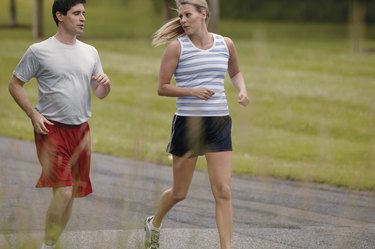
When you're short on time but still want to burn a few calories, you might be wondering if turning up the intensity can increase the calories burned jogging. The good news is, yes, you can turn your body into a calorie-burning machine even if you only have a limited amount of time to exercise.
Tip
Jogging at a 12-minute-mile pace can burn anywhere between 80 and 118 calories in 10 minutes.
Video of the Day
How Many Calories Burned Jogging?
The exact number of calories burned jogging depends on a variety of factors, such as your body weight, the intensity of exercise, age and gender. The Mayo Clinic points out that in general, men burn more calories than women because of lower body fat levels. Also, as you age, you lose muscle mass, which results in fewer calories burned.
Video of the Day
When you jog, you typically move at a slower pace than running or sprinting, which means you'll burn fewer calories in a 10-minute session than you would if you ran full out. That said, jogging is an excellent aerobic exercise that may be easier to sustain, especially if you're new to exercise or have a lower fitness level.
At a pace of 5 miles per hour, a 125-pound person will burn approximately 80 calories jogging for 10 minutes, according to Harvard Health Publishing.
At the same pace, a 155-pound person can burn about 100 calories, and and a 185-pound person will burn about 118 calories in 10 minutes of jogging.
How Much Exercise Is Enough?
For general health, the Physical Activity Guidelines for Americans recommend that adults get a minimum of 150 minutes each week of moderate-intensity cardiovascular or aerobic exercise such as jogging, walking or swimming. Additionally, two days of muscle-strengthening exercises are recommended, targeting all of the major muscle groups.
If you're aiming for the minimum of 150 minutes, that equates to five days of 30-minute cardio sessions. For additional health benefits, such as weight loss, the Centers for Disease Control and Prevention (CDC) suggests a higher amount of physical activity unless you also adjust your diet and calorie intake.
But what if you don't have a 30-minute block of time to exercise? Well, the good news, according to the Physical Activity Guidelines for Americans, if you increase the intensity of your running, you only need to exercise half the amount.
Read more: The Effects of Jogging Every Day
Benefits of Jogging
Other than burning calories, running has a multitude of health benefits that make this form of cardio worth including in your overall workout routine. And you don't have to be a marathoner or sprinter to benefit.
An August 2015 study published in the Journal of the American College of Cardiology examined the association between running and cardiovascular mortality risks in 55,137 adults and found that running, even five to 10 minutes a day, results in a reduced risk of death from cardiovascular disease.
Then, there are the mental health benefits of participating in a regular exercise program, such as decreasing anxiety and reducing stress.
A January 2013 review published in the Journal of Preventative Medicine and Public Health summarized studies on mental health that used exercise interventions and found that physical activity can lead to improvements in mood and a reduction in stress and the symptoms related to anxiety.
- Harvard Health Publishing: "Calories Burned in 30 Minutes for Three Different Weights"
- U.S. Department of Health and Human Services: "Physical Activity Guidelines for Americans"
- Centers for Disease Control and Prevention: "Physical Activity for a Healthy Weight"
- Journal of the American College of Cardiology: "Leisure-Time Running Reduces All-Cause and Cardiovascular Mortality Risk"
- Journal of Preventative Medicine and Public Health: "Exercise and Physical Activity in Mental Disorders: Clinical and Experimental Evidence"
- The Mayo Clinic: "Metabolism and Weight Loss: How You Burn Calories"
Was this article helpful?
150 Characters Max
0/150
Thank you for sharing!
Thank you for your feedback!